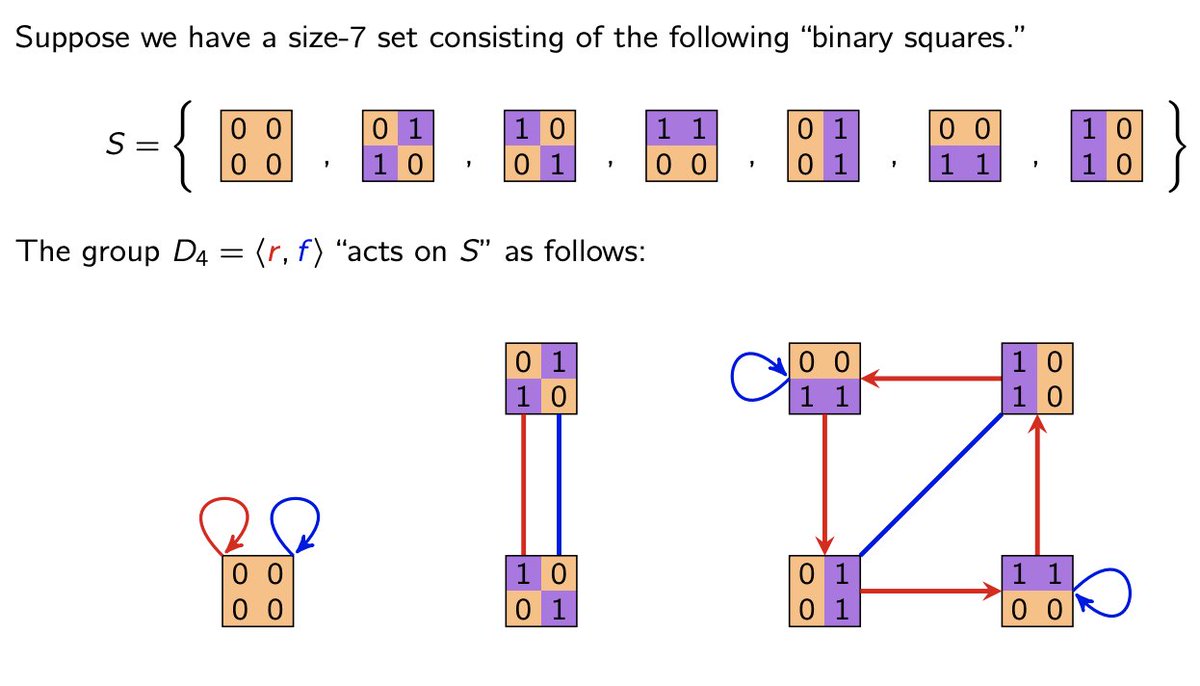Discover and read the best of Twitter Threads about #VisualAlgebra
Most recents (7)
Now that my #VisualAlgebra class is in the books, I want to post a long "meta thread" of all 16 weekly threads, with daily summaries. Here's my entire class, including lectures, HW, & exams, in one convenient place.
And stayed tuned for some surprise announcements below!👇🧵
And stayed tuned for some surprise announcements below!👇🧵

We started #Week1 of #VisualAlgebra with a few quotes from "A Mathematician's Apology" on the beauty of mathematics, and then saw Cayley diagrams for the symmetries of the rectangle and triangle.
In #Week2 of #VisualAlgebra, we explored the Rubik's cube, more Cayley diagrams, group presentations, the impossibility of the word & halting problems, and we classified all frieze groups.
I woke up a few days ago with the sobering realization: actually, I do NOT really understand groups actions.
Spoiler: I do now, but it took some work. And now I realize how incomplete my understanding was. 😳
Let me explain, I think some of you might enjoy this!
1/12 🧵👇
Spoiler: I do now, but it took some work. And now I realize how incomplete my understanding was. 😳
Let me explain, I think some of you might enjoy this!
1/12 🧵👇

Finishing up our🧵👇 #VisualAlgebra class in #Week15 with divisibility and factorization. I'm a little short on visuals, but here are two really nice ones on what we'll be covering, made by @linguanumerate.
Henceforth, we'll assume that R is an integral domain.
1/8 Mon

Henceforth, we'll assume that R is an integral domain.
1/8 Mon


The integers have nice properties that we usually take for granted:
--multiplication commutes
--there aren't zero divisors
--every nonzero number can be factored into primes
--any 2 nonzero numbers have a unique gcd and lcm
--the Euclidean algorithm can compute these
2/8 M
--multiplication commutes
--there aren't zero divisors
--every nonzero number can be factored into primes
--any 2 nonzero numbers have a unique gcd and lcm
--the Euclidean algorithm can compute these
2/8 M
Some, but not all of these hold in general integral domains. This is what we'd like understand!
If b=ac, we say "a divides b", or "b is a multiple of a".
If a | b and b | a, they're "associates", written a~b.
HW: a~b iff they differ by a unit (i.e., a=bu).
3/8 M
If b=ac, we say "a divides b", or "b is a multiple of a".
If a | b and b | a, they're "associates", written a~b.
HW: a~b iff they differ by a unit (i.e., a=bu).
3/8 M
We started #Week11 of #VisualAlgebra with a new diagram of one of the isomorphism theorems. I made this over spring break. The concept is due to Douglas Hofstadter (author of "Gödel, Escher, Bach"), who calls this a "pizza diagram".
1/14 Mon 🧵👇
1/14 Mon 🧵👇

We started #Week7 in #VisualAlgebra yesterday with the tower law.
Here are two ways to think about it. One involves cosets as "boxes" in a grid, and the other is in terms of the subgroup lattice: to find the index [H:K], just take the product of the edges b/w them.
1/8 Mon

Here are two ways to think about it. One involves cosets as "boxes" in a grid, and the other is in terms of the subgroup lattice: to find the index [H:K], just take the product of the edges b/w them.
1/8 Mon


WEEK 2 of #VisualAlgebra! This is only Lecture #2 of the class.
Monday was MLK Day, but on Wed, we learned about the Rubik's cube! I got to show up my rare signed cube with Ernő Rubik himself from 2010! Did a shout out to @cubes_art's amazing talents.
1/8 W


Monday was MLK Day, but on Wed, we learned about the Rubik's cube! I got to show up my rare signed cube with Ernő Rubik himself from 2010! Did a shout out to @cubes_art's amazing talents.
1/8 W


WEEK 1: first lecture of #VisualAlgebra.
"The mathematician's patterns, like the painter's or the poet's must be beautiful; the ideas like the colours or the words, must fit together in a harmonious way."
― G.H. Hardy, A Mathematician's Apology
1/4
"The mathematician's patterns, like the painter's or the poet's must be beautiful; the ideas like the colours or the words, must fit together in a harmonious way."
― G.H. Hardy, A Mathematician's Apology
1/4
















